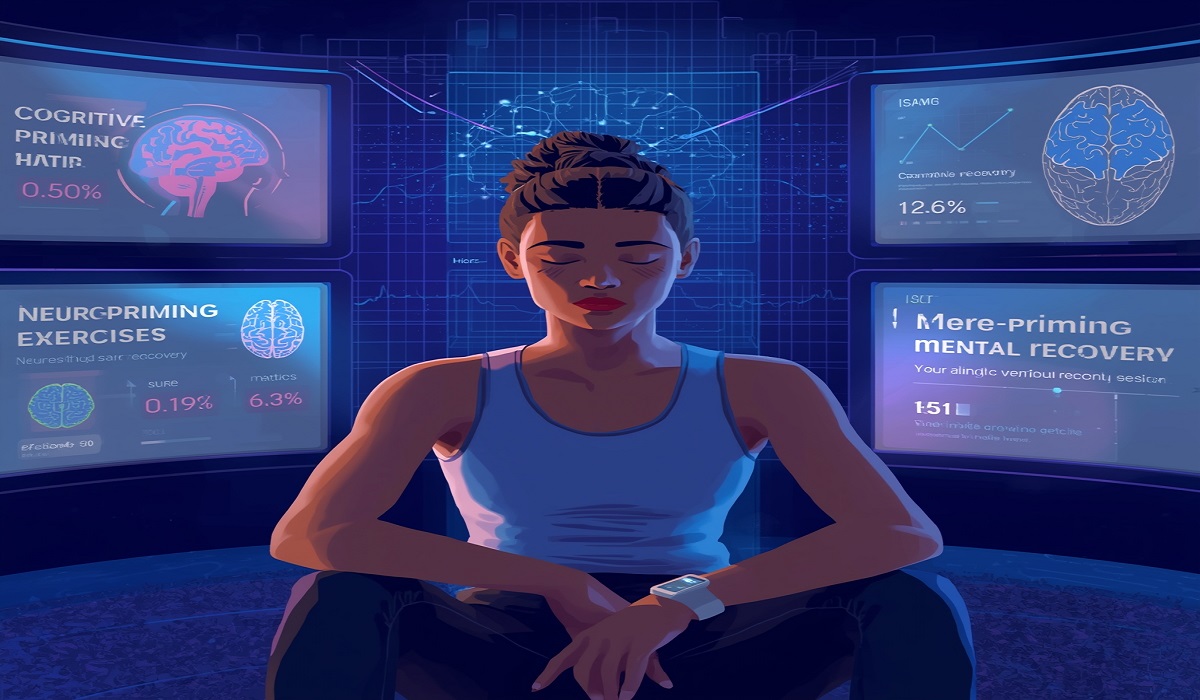Neuro-priming for Athlete Cognitive Recovery
Neuro-priming for Athlete Cognitive Recovery: Have you ever finished a long gaming session feeling mentally drained? Your reactions slow, your focus fuzzy, and your decision-making just a bit off? This is cognitive fatigue, and for professional esports athletes and traditional sports stars, it is a major hurdle to peak performance.
Just as a runner’s muscles need to recover, an athlete’s brain needs a reset. In 2025, a powerful mental recovery tool is gaining attention. This article explains the concept of Neuro-priming for athlete cognitive recovery 2025. We will look at how this method helps players get their minds back in the game faster and stronger.
Neuro-priming for Athlete Cognitive Recovery: A 2025 Perspective
In the world of high-level competition, the difference between winning and losing is often a matter of milliseconds and razor-sharp decisions. For years, training focused on the body. Now, we understand that the brain is the most important muscle of all. Athletes in 2025 face immense mental pressure, leading to cognitive fatigue that can harm their performance.
This is where the innovative approach of Neuro-priming for athlete cognitive recovery 2025 comes into play. It is not about playing more games or running more drills. It is about using gentle, targeted stimulation to prepare the brain to learn and recover more effectively. This guide will walk you through what this process is, how it functions, and why it is becoming a essential part of an athlete’s routine.
What is Neuro-priming and How Does It Help Athletes?
Neuro-priming is a technique that prepares the brain for learning and recovery. Think of it like warming up your muscles before exercise, but for your mind. It uses very gentle, safe levels of electrical stimulation to make the brain more receptive. This state of readiness helps the brain form new connections faster. For an athlete, this means that the skills they practice after a neuro-priming session can stick better and faster.
The core idea behind Neuro-priming for athlete cognitive recovery is to combat mental tiredness. After intense focus, an athlete’s brain can feel slow. This method aims to speed up the brain’s natural healing process. It does not put any new information into the brain. Instead, it optimizes the brain’s own wiring to perform at its best. This makes training sessions more productive and helps an athlete return to a fresh, focused state more quickly after a tough match or event.
- Pre-Activity Priming: Used before a training session to enhance learning and skill acquisition.
- Post-Activity Recovery: Used after competition or strenuous mental effort to reduce cognitive fatigue and speed up mental refresh.
The Connection Between Brain Function and Athletic Performance
To understand why Neuro-priming for athlete cognitive recovery 2025 is so effective, we need to see how the brain and body work together. Your brain is the command center for every move you make. When a soccer player makes a split-second pass or a gamer lands a perfect headshot, it is not just luck. It is the result of complex brain processes involving focus, decision-making, and motor control.
Cognitive fatigue happens when the brain’s prefrontal cortex, the area responsible for complex thought and focus, gets tired. When this part of the brain is worn out, an athlete’s performance drops. They might miss cues, react slower, or make poor strategic choices.
The goal of cognitive recovery is to give this part of the brain a rest and help it recharge. Techniques like Neuro-priming for athlete cognitive recovery are designed specifically to support this mental recharge, ensuring the brain can keep up with the demands of the body.
Key Benefits of Using Neuro-priming for Mental Recovery
Adopting a Neuro-priming for athlete cognitive recovery routine offers several powerful advantages. These benefits are why more teams and individual competitors are integrating it into their schedules in 2025.
One major benefit is improved focus and attention. By reducing mental clutter, athletes can concentrate on the task at hand without being easily distracted. This is crucial in a noisy stadium or during a high-stakes tournament.
Another significant advantage is faster reaction times. A primed brain can process visual and auditory information more quickly, leading to speedier physical responses.
- Reduced Mental Fog: Helps clear up feelings of sluggishness after long periods of concentration.
- Enhanced Skill Learning: Makes practice more effective by helping the brain solidify new techniques.
- Better Stress Management: Can help calm the nervous system, allowing athletes to stay composed under pressure.
- Quicker Bounce-Back: Shortens the time needed to feel mentally ready after a demanding event.
How Neuro-priming Techniques Work in a Training Program?
So, what does a Neuro-priming for athlete cognitive recovery 2025 session actually look like? It is a simple and non-invasive process. An athlete typically wears a headset that delivers a very mild electrical current to specific parts of the scalp. This current is so faint that most people do not feel much more than a slight tingling. This technique is called transcranial Direct Current Stimulation (tDCS).
A session might last for 10 to 20 minutes. Often, an athlete will use the neuro-priming device right before a focused training session. This prepares their brain to absorb new strategies or physical skills.
Alternatively, they might use it after a game as part of their cool-down routine to kickstart the cognitive recovery process. The key is consistency. Using Neuro-priming for athlete cognitive recovery as a regular part of training, much like stretching or hydration, yields the best long-term results for mental sharpness.
A Look at the Technology Behind Modern Neuro-priming
The technology that powers Neuro-priming for athlete cognitive recovery has become more advanced and user-friendly by 2025. Early systems were large and only found in labs. Today, athletes can use portable, wearable devices. These headsets are designed for easy use at home, in the training room, or even while traveling.
These modern devices use sophisticated software to ensure the stimulation is applied safely and to the correct brain region. Sensors can check the contact with the scalp to maintain a consistent current. Many devices now pair with smartphone apps.
These apps allow the athlete or their coach to track session data and monitor progress over time. The evolution of this technology has made the benefits of Neuro-priming for athlete cognitive recovery 2025 accessible to a wider range of competitors, not just those with the biggest budgets.
Neuro-priming in Action: Use Cases for Esports Players
Esports is a perfect example of an industry where Neuro-priming for athlete cognitive recovery provides a significant edge. Esports players rely entirely on cognitive abilities: lightning-fast reactions, sustained attention, and complex tactical thinking. Their minds are their primary athletic tool.
An esports player might use neuro-priming before a scrimmage to enhance their learning of a new game patch. After a long day of competition, they might use it to help quiet their mind and recover from mental exhaustion, improving their sleep quality.
The application of Neuro-priming for athlete cognitive recovery 2025 in esports helps players maintain a high level of performance throughout long seasons and avoid burnout. It is a practical tool for keeping the brain as trained and resilient as the fingers on the keyboard.
Implementing a Neuro-priming Routine for Optimal Results
Starting with Neuro-priming for athlete cognitive recovery should be done thoughtfully. It is not a magic bullet but a tool that works best as part of a holistic health plan. An athlete should first identify their primary goal. Are they looking to learn faster, recover quicker, or improve focus during games?
A simple starter routine could involve a 15-minute session three times a week before a key training activity. It is important to use the device as directed by the manufacturer and to be patient. The effects of Neuro-priming for athlete cognitive recovery are often subtle at first and build up over several weeks. Combining this technology with other healthy habits like good nutrition, physical exercise, and proper sleep creates a powerful synergy for overall cognitive health.
The Future of Cognitive Training for Athletes
The field of Neuro-priming for athlete cognitive recovery 2025 is still growing. Researchers are constantly learning more about how to optimize these techniques. In the near future, we can expect even more personalized approaches. Devices might use artificial intelligence to tailor the stimulation to an athlete’s unique brain patterns on any given day.
Furthermore, the combination of neuro-priming with virtual reality (VR) training is a exciting frontier. An athlete could put on a VR headset for a fully immersive cognitive workout that is specifically designed for their sport. The progress in Neuro-priming for athlete cognitive recovery points toward a future where mental training is just as measurable, specific, and important as physical training.
Frequently Asked Questions (FAQs)
1. Is neuro-priming safe for athletes to use?
Yes, when used with devices cleared by health authorities and according to instructions, neuro-priming is considered safe. The technology uses very low levels of stimulation that are not harmful.
2. How long does it take to see results from neuro-priming?
Some people notice slight improvements in focus after a single session, but lasting changes usually appear after several weeks of consistent use as part of a structured training plan.
3. Can neuro-priming replace other forms of cognitive training?
No, it is a supplement, not a replacement. Neuro-priming works best when it is used to enhance other healthy practices like good sleep, physical activity, and traditional skill practice.
4. Who can benefit from this type of cognitive recovery?
While designed for high-performance athletes, anyone whose hobby or job requires intense mental focus, such as students, programmers, or musicians, may find benefits from these principles.
5. Are the effects of neuro-priming long-lasting?
The positive effects on learning and recovery can be long-lasting, especially with regular use. However, like physical exercise, maintaining the benefits requires an ongoing commitment.
Conclusion
The world of sports is increasingly recognizing that a strong body needs a strong, well-recovered mind to succeed. Neuro-priming for athlete cognitive recovery 2025 represents a significant step forward in how we approach mental fitness in competition.
This method offers a practical, science-backed way to help athletes train smarter, recover faster, and protect their most valuable asset—their cognitive function. As this technology continues to develop, it will likely become a standard part of the toolkit for anyone serious about achieving and sustaining peak performance.







